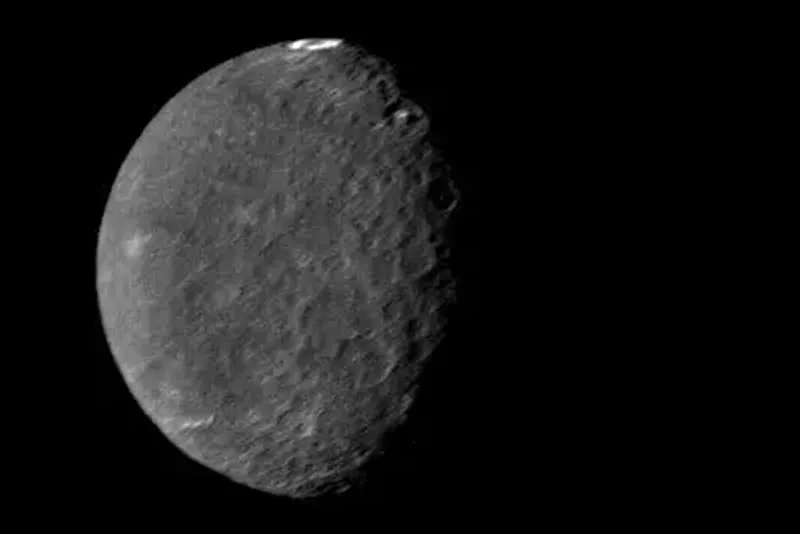Uranus is currently known to have 27 moons, which can be broken down into three groups. There are 5 major moons, 13 inner moons and nine irregular moons.
Uranus's 5 largest moons are the planet's largest by some distance, and are - in order of largest first - Titania, Oberon, Ariel, Umbriel and Miranda.
Miranda is the smallest of Uranus's major inner moons, while Uranus's largest moon is Titania, with a radius of 789km.
We’ve known about some of Uranus's moons since the late 18th century, while others were discovered much more recently – not until 2003, in the case of Margaret – and they vary immensely in terms of size, mass and orbital distance, as can be seen in the table Uranus's Moons at a glance below.

Uranus moons, Shakespeare and Pope
What Uranus's moons all have in common is that they’re all named after characters from Shakespeare. Well, almost!
The exceptions are Belinda and Umbriel, both of which are named after characters from a poem by Alexander Pope (1688-1744).
Ariel, meanwhile, is a name that appears in works by both Shakespeare AND Pope.
Exactly why Uranus’s moons are named after Shakespearean characters isn’t, however, entirely clear.
Uranus was discovered by William Herschel in 1781, swiftly followed by Titania – Uranus’s largest moon, with a radius of 789km – and Oberon in 1787.

But Herschel himself never named the two satellites, referring to them only as ‘number one’ and ‘number two’.
Nor is there anything in the letters, notes and papers he left behind to suggest Herschel was a lover of Shakespeare.
Rather, it appears to have been his son John Herschel who gave the two moons their names, during his tenure as president of the Royal Astronomical Society.
However, this was around the same time that another astronomer, William Lassell, discovered two more moons – the aforesaid Ariel and Umbriel – in 1851, and there is some debate as to whether it was Herschel or Lassell who came up with the four names.
Voyager Uranus moon discoveries

The fifth major moon of Uranus wasn’t discovered until 1948, when Gerard Kuiper (after whom the Kuiper Belt is named) dubbed it Miranda, after a character from The Tempest.
A precedent was now set.
Voyager 2 is so far the only spacecraft to have visited Uranus, when it flew by the planet in 1986.
At that time, Voyager 2 found 10 new moons around Uranus, much smaller than those that had been discovered by astronomers on Earth.
When Voyager 2 discovered a further 10 much smaller moons orbiting Uranus at a much closer distance than the 5 major ones, these too were given Shakespearean names.

Modern Uranus Moon discoveries
Since the 1980s, astronomers have discovered a further 12 moons at Uranus: 3 more inner moons and 9 tiny, irregular ones that orbit the planet on large, eccentric orbits.
And again, the scientists tasked with naming them turned to the Bard’s Complete Works for inspiration.
Astronomers Brett Gladman and John Kavelaars, for instance, led a team that discovered several Uranian moons in the late 1990s – and they named them carefully.
The first was dubbed Caliban, a character who appears (as the moon had) out of the dark, while Trinculo and Stephano, which both have highly erratic orbits, were named after drunken characters in The Tempest.

In 1999, astronomer Erich Karkoschka found another moon around Uranus in the images captured by Voyager 2 some 13 years later, while comparing the spacecraft's images of the Uranus system with those taken by the Hubble Space Telescope.
Perdita was confirmed as a moon in 2003.
There is much more we still need to learn about Uranus, and who knows if there are yet more small moons out there, just waiting to be discovered?
But for now, here are all the ones we know about…

Uranus's moons at a glance
Key stats about all of Uranus’s 27 moons, from largest to smallest.
Titania
- Discovered: 11 January 1787 by William Herschel
- Average orbital distance: 435,900km
- Radius: 788km
- Named after: The queen of the fairies in A Midsummer Night’s Dream
Oberon
- Discovered: 11 January 1787 by William Herschel
- Average orbital distance: 583,500km
- Radius: 761km
- Named after: The king of the fairies in A Midsummer Night's Dream
Umbriel
- Discovered: 24 October 1851 by William Lassell
- Average orbital distance: 266,300km
- Radius: 585km
- Named after: A spirit who appears in Pope’s The Rape of the Lock
Ariel
- Discovered: 24 October 1851 by William Lassell
- Average orbital distance: 191,000km
- Radius: 579km
- Named after: A spirit in The Tempest who also appears in Pope’s The Rape of the Lock
Miranda
- Discovered: 16 February 1948 by Gerard P. Kuiper, McDonald Observatory
- Average orbital distance: 129,400km
- Radius: 235km
- Named after: The female lead in The Tempest
Puck
- Discovered: 30 December 1985 in Voyager 2 images
- Average orbital distance: 86,000km
- Radius: 81km
- Named after: The mischievous fairy in A Midsummer Night’s Dream
Sycorax
- Discovered: 6 September 1997 by Philip D. Nicholson, Brett J. Gladman, Joseph A. Burns, John J. Kavelaars, 200-inch Hale Telescope at Palomar Observatory
- Average orbital distance: 12,179,400km
- Radius: 79km
- Named after: Caliban’s mother (and a witch) in The Tempest.
Portia
- Discovered: 3January 1986 in Voyager 2 images
- Average orbital distance: 66,100km
- Radius: 68km
- Named after: A character in The Merchant of Venice.
Juliet
- Discovered: 3 January 1986 in Voyager 2 images
- Average orbital distance: 64,400km
- Radius: 47km
- Named after: The female protagonist in Romeo & Juliet
Belinda
- Discovered: 13 January 1986 in Voyager 2 images
- Average orbital distance: 75,300km
- Radius: 45km
- Named after: A character in Alexander Pope’s The Rape of the Lock
Cressida
- Discovered: 9 January 1986 in Voyager 2 images
- Average orbital distance: 61,800km
- Radius: 40km
- Named after: The female protagonist in Troilus and Cressida
Caliban
- Discovered: 6 September 1997 by B. Gladman, P. Nicholson, J. A. Burns, J. Kavelaars, Palomar Observatory
- Average orbital distance: 7,231,100km
- Radius: 36km
- Named after: A major character in The Tempest
Rosalind
- Discovered: 13January 1986 in Voyager 2 images
- Average orbital distance:69,900km
- Radius: 36km
- Named after: A character in As You Like It
Desdemona
- Discovered: 13 January 1986 in Voyager 2 images
- Average orbital distance: 62,700km
- Radius: 32km
- Named after: Othello’s wife in Othello
Bianca
- Discovered: 23 January 1986 in Voyager 2 images
- Average orbital distance: 59,200km
- Radius: 26km
- Named after: Katherine’s sister in The Taming of the Shrew
Prospero
- Discovered: 18 July 1999 by Matthew J. Holman, John J. Kavelaars, Brett J. Gladman, Jean-Marc Petit, Hans Scholl, Canada-France-Hawaii Telescope
- Average orbital distance: 16,276,800km
- Radius: 25km
- Named after: The sorcerer in The Tempest
Setebos
- Discovered: 18 July 1999 by Matthew J. Holman, John J. Kavelaars, Brett J. Gladman, Jean-Marc Petit, Hans Scholl, Canada-France-Hawaii Telescope
- Average orbital distance: 17,420,400km
- Radius: 24km
- Named after: The god worshipped by Caliban and Sycorax in The Tempest.
Ophelia
- Discovered: 20 January 1986 in Voyager 2 images
- Average orbital distance: 53,800km
- Radius: 21km
- Named after: Polonius’s daughter and Hamlet’s fiancée in Hamlet
Cordelia
- Discovered: 20 January 1986 in Voyager 2 images
- Average orbital distance: 49,800km
- Radius: 20km
- Named after: King Lear’s daughter in King Lear
Stephano
- Discovered: 18 July 1999 by Brett Gladman, Matthew Holman, John J. Kavelaars, Jean-Marc Petit, Hans Scholl, Canada-France-Hawaii Telescope
- Average orbital distance: 8,007,400km
- Radius: 16km
- Named after: A drunken butler in The Tempest
Perdita
- Discovered: 18 May 1999 by Erich Karkoschka, in archive Voyager 2 images
- Average orbital distance: 76,400km
- Radius: 15km
- Named after: The daughter of Leontes and Hermione in The Winter’s Tale
Fransisco
- Discovered: 13 August by John J. Kavalaars, Matthew J. Holman, Dan Milisavljevic, Tommy Grav, Cerro Tololo Inter-American Observatory
- Average orbital distance: 4,282,900km
- Radius: 11km
- Named after: A lord in The Tempest
Ferdinand
- Discovered: 13 August 2001 by Dan Milisavljevic, Matthew J. Holman, John J. Kavelaars, Tommy Grav, Cerro Tololo Inter-American Observatory
- Average orbital distance: 20,430,100km
- Equatorial radius: 10km
- Named after: The son of Alonso in The Tempest
Margaret
- Discovered: 29 August 2003 by Scott S. Sheppard, David C. Jewitt, Subaru 8.2-m reflector at Mauna Kea Observatory
- Average orbital distance: 14,146,700km
- Radius: 10km
- Named after: Hero’s servant in Much Ado About Nothing
Cupid
- Discovered: 25 August 2003 by M.R. Showalter, J.J. Lissauer, Hubble Space Telescope
- Average orbital distance: 74,800km
- Radius: 9km
- Named after: A character in Timon of Athens
Mab
- Discovered: 23 August 2003 by M.R. Showalter, J.J. Lissauer, Hubble Space Telescope
- Average orbital distance: 97,700km
- Radius: 9km
- Named after: A fairy queen who is mentioned in Romeo & Juliet
Trinculo
- Discovered: 13 August 2001 by Matthew Holman, John J. Kavelaars, Dan Milisavljevic, Dominion Astrophysical Observatory, Cerro Tololo Inter-American Observatory
- Average orbital distance: 8,505,200km
- Radius: 9km
- Named after: A jester in The Tempest
Notes:
- All radii are approximate averages, as many of Uranus’s outer moons are irregular in shape
- All orbital distances rounded to the nearest 100km
- All literary works by William Shakespeare except where stated

